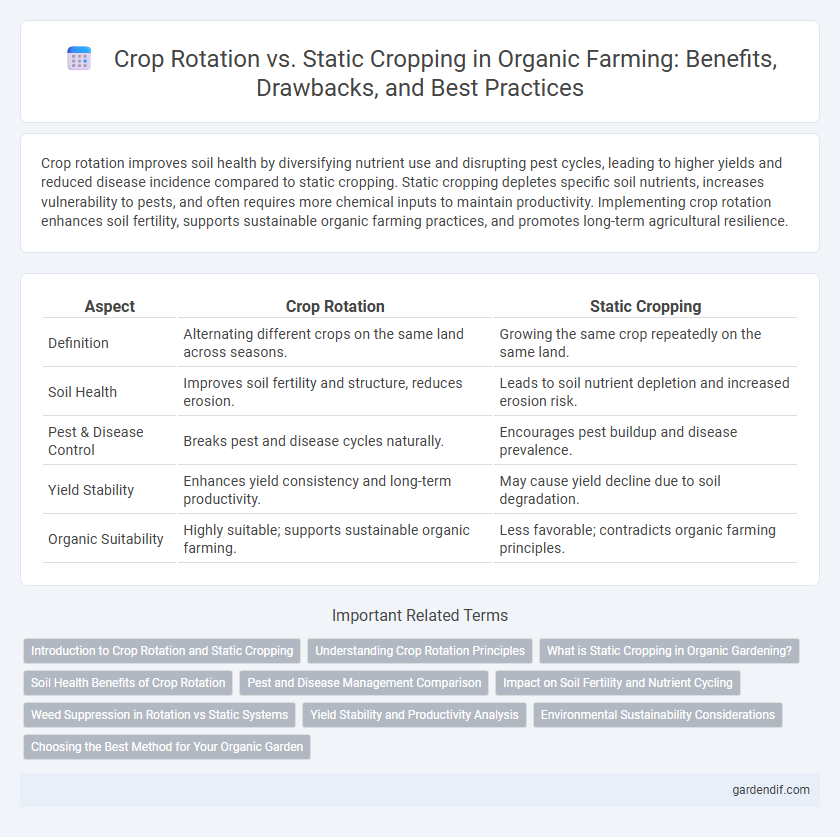
Crop rotation vs Static cropping Illustration
Crop rotation improves soil health by diversifying nutrient use and disrupting pest cycles, leading to higher yields and reduced disease incidence compared to static cropping. Static cropping depletes specific soil nutrients, increases vulnerability to pests, and often requires more chemical inputs to maintain productivity. Implementing crop rotation enhances soil fertility, supports sustainable organic farming practices, and promotes long-term agricultural resilience.
Table of Comparison
| Aspect | Crop Rotation | Static Cropping |
|---|---|---|
| Definition | Alternating different crops on the same land across seasons. | Growing the same crop repeatedly on the same land. |
| Soil Health | Improves soil fertility and structure, reduces erosion. | Leads to soil nutrient depletion and increased erosion risk. |
| Pest & Disease Control | Breaks pest and disease cycles naturally. | Encourages pest buildup and disease prevalence. |
| Yield Stability | Enhances yield consistency and long-term productivity. | May cause yield decline due to soil degradation. |
| Organic Suitability | Highly suitable; supports sustainable organic farming. | Less favorable; contradicts organic farming principles. |
Introduction to Crop Rotation and Static Cropping
Crop rotation involves systematically alternating different crops in the same field across seasons to improve soil health, reduce pest buildup, and enhance nutrient availability. Static cropping, or monoculture, repeatedly grows the same crop on the same land, often leading to soil nutrient depletion and increased vulnerability to pests and diseases. Implementing crop rotation promotes sustainable agriculture by maintaining soil fertility and reducing reliance on chemical inputs.
Understanding Crop Rotation Principles
Crop rotation enhances soil fertility by alternating different crops, disrupting pest cycles and reducing disease buildup compared to static cropping, which involves planting the same crop continuously. This practice improves nutrient management, as legumes fix nitrogen benefiting subsequent crops, and diverse root structures promote soil health. Understanding these principles is essential for optimizing organic farming systems and achieving sustainable yields.
What is Static Cropping in Organic Gardening?
Static cropping in organic gardening refers to the practice of planting the same crop in the same location season after season without rotation. This method can lead to soil nutrient depletion, increased pest and disease buildup, and reduced soil fertility over time. Organic gardeners often avoid static cropping to maintain soil health, promote biodiversity, and improve crop yields through sustainable practices.
Soil Health Benefits of Crop Rotation
Crop rotation significantly enhances soil health by naturally replenishing nutrients and reducing pest and disease buildup compared to static cropping. Diverse crop sequences improve soil structure, increase microbial diversity, and boost organic matter content, leading to better water retention and nutrient cycling. These benefits contribute to sustainable productivity and long-term soil fertility in organic farming systems.
Pest and Disease Management Comparison
Crop rotation enhances pest and disease management by interrupting pest life cycles and reducing pathogen buildup in the soil, leading to healthier organic crops. Static cropping, where the same crop is planted repeatedly, often increases the risk of pest infestations and soil-borne diseases due to continuous host availability. Implementing diverse crop rotations improves soil biodiversity and natural pest control, minimizing the need for synthetic pesticides in organic farming systems.
Impact on Soil Fertility and Nutrient Cycling
Crop rotation significantly enhances soil fertility by diversifying nutrient uptake and replenishment, reducing the risk of soil nutrient depletion common in static cropping systems. This practice promotes effective nutrient cycling through the alternating growth of legumes and cereals, which naturally fix nitrogen and improve soil organic matter content. In contrast, static cropping often leads to nutrient imbalances and soil degradation due to continuous monoculture, hindering long-term soil health and productivity.
Weed Suppression in Rotation vs Static Systems
Crop rotation significantly enhances weed suppression by disrupting weed life cycles and reducing weed seed banks through diverse planting schedules, unlike static cropping that allows specific weed species to dominate due to repetitive monoculture practices. Rotational systems increase soil health and biodiversity, promoting natural weed control agents and reducing reliance on herbicides. This dynamic approach minimizes weed pressure over time, improving organic crop yield and sustainability compared to static cropping methods.
Yield Stability and Productivity Analysis
Crop rotation significantly enhances yield stability by disrupting pest and disease cycles, improving soil structure, and promoting nutrient diversity, which leads to higher and more consistent crop productivity over time. In contrast, static cropping depletes specific soil nutrients and increases vulnerability to pests, resulting in lower and more fluctuating yields. Studies indicate that fields practicing diverse crop rotations experience 20-30% greater average yields and reduced yield variability compared to monoculture systems.
Environmental Sustainability Considerations
Crop rotation enhances environmental sustainability by improving soil health, reducing pest and disease buildup, and minimizing the need for chemical inputs, which helps preserve biodiversity and ecosystem balance. Static cropping depletes soil nutrients, increases vulnerability to pests, and often leads to higher reliance on synthetic fertilizers and pesticides, contributing to soil degradation and environmental pollution. Implementing diverse crop rotations supports carbon sequestration and water retention, promoting long-term agricultural resilience and ecological sustainability.
Choosing the Best Method for Your Organic Garden
Crop rotation enhances soil health by disrupting pest and disease cycles while replenishing nutrients, making it ideal for organic gardens aiming for sustained productivity. Static cropping can lead to nutrient depletion and increased vulnerability to pests but may suit small-scale or space-limited gardens with consistent crop preferences. Selecting the best method depends on garden size, crop variety, and long-term soil fertility goals, with crop rotation generally favored for maintaining ecological balance in organic systems.
Crop rotation vs Static cropping Infographic

 gardendif.com
gardendif.com